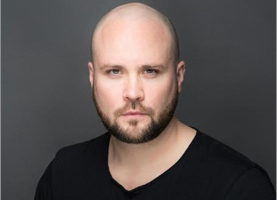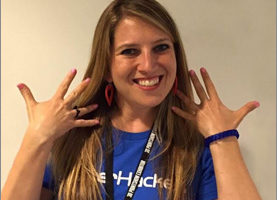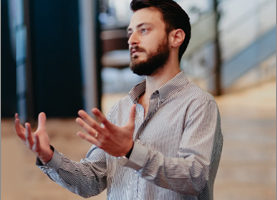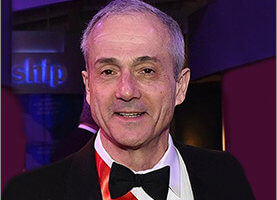In this podcast, Thomas E. Lovejoy, Senior Fellow, United Nations Foundation, talks candidly about his life’s work as an advocate for environmental conservation.
Lovejoy talks in detail about biodiversity and his extensive work in environmental science. He explains how his early interest in animals, biology, and eventually his work in graduate school led him to his career in environmental science and conservation.
Lovejoy talks about his time with the WWF (World Wildlife Fund) and his years of work studying and researching the Amazon in Brazil. Lovejoy talks about what happens when a forest breaks into fragments. As he states, a forest that is broken into fragments creates a situation in which these fragments are no longer part of a larger system, and as they are no
longer part of the larger ecosystem the fragments lose the ability to support the species contained within.
The biodiversity science expert discusses drought and deforestation. And he talks about some of the ways that we can back off the tipping point by pursuing reforestation, and working to build new connections between the various forest fragments. Lovejoy discusses treefall gaps (holes in a forest with vertical sides) and he provides a detailed explanation of how seeds are distributed and why certain small animal species are so crucially important to the process.
Wrapping up, Lovejoy explains the negative impacts of greater amounts of carbon in the atmosphere and how that is directly affecting climate change.
Richard Jacobs: Hello, this is Richard Jacobs with the future tech and future tech health podcast. I have Tom Lovejoy. He’s a senior fellow dealing with biodiversity and environmental science, senior fellow of the United Nations Foundation. So Tom, thanks for coming. How are you doing?
Thomas E. Lovejoy: Just fine. Thanks. Good to talk to you.
Richard Jacobs: I can see from your bio you’ve been, some forty-odd years you been involved in biodiversity and things like that. So what got you involved initially in caring about biodiversity and issues like this and environmental science?
Thomas E. Lovejoy: I was just a kid that liked animals and I ended up taking a biology course. I thought to get this subject over with when I was 14 and I just got totally turned on to the variety of life and I’ve never been able to get enough.
Richard Jacobs: So what kind of activities have you been involved in? Had you been involved in surveys looking at life across the planets or a specific regional issues as it pertains to wildlife for?
Thomas E. Lovejoy: Basically back when I was in graduate school the environmental imperative was not quite so obvious. And so I basically thought I’d have a great career just having scientific adventures. And that is in fact what took me to the Amazon in 1965 and it was a grand adventure. But then as time went on, I began to see what was happening to life on earth and helped create science and conservation biology and got engaged through world wildlife fund where I worked for 14 years and leading conservation efforts internationally. And then I worked at World Bank, then with the Smithsonian. Always looking to create a better future for life on earth.
Richard Jacobs: You said you went through the Amazon in 1965 and you’ve been back since?
Thomas E. Lovejoy: I am always on my way to the Amazon. So I lived there for two years in 1967 to 69. I actually do my Ph.D. and started working for the world wildlife fund in 1973 and was back in Brazil within a couple of years of doing that and worked a lot with Brazil on conservation. And the major pieces of that were in the Amazon. And then I started a science research project 40 years ago on the central Amazon to try and understand what happens when you break a forest up into fragments. Because it’s not really obvious at the moment the fragments are created, but when a fragment is no longer part of a larger system, it basically can’t support all the species that are in it. At the time it becomes an isolated fragment. So much like a radioactive mineral sheds radioactivity and becomes something simpler. So do forest fragments shed some of their species and become simpler ecosystems.
Richard Jacobs: At what scale does that happen?
Thomas E. Lovejoy: It will depend on the kind of forests, but I think probably for the Amazonian forest you need a minimum size of something like a thousand square kilometers, which is really big, but it isn’t because of the Amazon itself is as big as the 48 US States. And one of the really encouraging things is once I started all that research, most of the protected areas in the Amazon have been at least that size or larger.
Richard Jacobs: Okay. So that thousand square kilometers, what would be that in miles?
Thomas E. Lovejoy: So that would be a hundred kilometers on aside. No, it’s more like 333 kilometers on aside. But I was going to translate it into acres for you. So a thousand square kilometers is a hundred thousand hectares and that’s sort of like 250,000 acres.
Richard Jacobs: Oh wow. What’s been observed to happen when you have a chunk that’s smaller than that?
Thomas E. Lovejoy: So in this research, we were able to show that a hundred-hectare fragment, like 250 acres loses half of the forest interior bird species in less than 15 years. And so that’s pretty dramatic, right? Basically, all those bird species don’t like to go out into the sunlight. So they are there with populations initially, which are too small or their food supplies inadequate or whatever.
Richard Jacobs: Oh. So there’s not enough resilience in a given system if it’s too small. Maybe there’s just not enough range for certain features to move. It changes probably density patterns and fundamental ability and all kinds of stuff.
Thomas E. Lovejoy: Yeah. And some of these species are actually quite rare, so you might only get one pair per thousand hectares. And so they’re either in that initial fragment or not even there.
Richard Jacobs: Hmm. I got you.
Thomas E. Lovejoy: And if they needed more than a hundred hectares, but happened to be in the fragment when it was created they just don’t have the resources to support themselves over time.
Richard Jacobs: Right. When was the most recent time you went to the Amazon and observed it and how much it has changed and how much is it changed?
Thomas E. Lovejoy: So the last time I was there was in July, and I’ll go again in a couple of weeks and again in November and again at the end of the year. So when I first started there was only 3% of the Amazon was deforested. Today the Brazilian portion of it is close to 20% deforested. And that’s very worrisome because Amazon makes half of its own rain. And if there’s not enough rain, the duck gets a rain forest. I get more of grassland vegetation. So at the moment, the Amazon is very close to a tipping point, which would change the forest in the South and the East and maybe part of the central Amazon, just some kind of grassland.
Richard Jacobs: Oh wow. So the Amazon is deforested, you said the Brazil portion like 20 some odd percent, but then even before station or is it made it into a patchwork? Two small fragments.
Thomas E. Lovejoy: So it varies. Some places it’s pretty extensive. Other places it’s spontaneous colonization along highways or things like that, where you tend to get a progression? From the initial small clearings to a lot of clearing to extensive cleared areas unless as it happened in certain instances, those areas are abandoned. And then you get some kind of second-growth coming back. So it dynamic, but it’s very close to the tipping point. We think we see the initial flickering because there are unprecedented droughts every five years now.
Richard Jacobs: Oh wow. So what does that tell you? And the best ways to fix the problem? Is it link up areas that are separated? Is it changed? You know, like maybe if you assume deforestation at some level is going to happen regardless. Can that be allowed to happen but change the dynamic or the method of it? They may make it less impactful. I mean, what are some of the learning you’ve gotten from all this?
Thomas E. Lovejoy: So the first thing you want to do is back off from the tipping point. And the most important thing that can be done to do that is to do some reforestation and Brazil actually made commitments in Paris about reforestation to be concentrated. Some of that in the Amazon. You could back off of the tipping point and then the rest of the landscape, it would be smart to essentially build as many connections between forest fragments as you possibly can.
Richard Jacobs: Okay. So has there been any tests or observation of if you have two forest fragments and you connect them, what is the connection look like? Is it has to be a very wide connection in a certain shape, is it to be multiple connections in order for them to be able to act as one and preserve themselves.
Thomas E. Lovejoy: So in fact, there was a recent paper this week in science, which I haven’t had time to read yet about the benefits of re-establishing connections. But basically, first of all, you would want to have vegetation along the edge of watercourses and prevent soil erosion and protect water quality. And that’s an easy way to put a lot of connections back in the natural landscape. And then basically the rest of it is looking at a particular landscape, looking where the opportunities for restoring connections are most favorable. And just going with us.
Richard Jacobs: How hard is it? I mean, can you fix an area that has been cleared or is that infinitely harder than to just prevent an area from being cleared?
Thomas E. Lovejoy: Well, it’s always easier to prevent than fix. I mean, it’s a little like not trying to put the toothpaste back in the toothpaste tube. But it can be done. A lot depends on what has actually happened to the land. So if there has been extensive use of fire the natural succession is much less favorable to restoring something which is species-rich, like a typical tropical rain forest. If there is not been extensive use of fire, you get a different vegetation succession, which basically mimics what happens in tree fall areas in the forest. You get a lot of fast-growing things that grow up and they create shade, which creates opportunities for the big seated far as canopy species to get started in the shade.
Richard Jacobs: Is there a way to partially work on a cleared area? So if we want to fix an area, can you do a partial work on it and then nature takes and finishes it or you have to go all the way and shepherd the given area till it’s 100% back to normal?
Thomas E. Lovejoy: Well, it’s a really good question. And it depends on how big the cleared area is and how severe the impact was on the cleared area. But basically speaking, if the clearing has been done without fire and it’s not a very big clearing, it pretty much can recover on its own. If it’s a bigger clearing, it takes a much longer time. And that’s because the forest canopy tree species generally have very large seeds, and that requires in nature for a small mammal to actually move it and bury it somewhere, hoping to come back and then forgetting so in the bigger clearings, you don’t really have that kind of ecosystem service from forests, rodents, or primates or whatever it might be. But Rio de Janeiro has the largest urban forest in the world and that was reforested in the middle of the 19th century because the emperor Brazil was really concerned about the Rio watershed. And although there were some trees involved in that restoration, which were not native species basically the Tijuca forest, which is its name is a very healthy tropical forest.
Richard Jacobs: Okay. If you have given clarity to the area, what would be a better way to fix it? Let’s say I’m listening, I just picture like a big square that’s cleared, would you start to fix things in the middle or on the edges and had them creep in, you have to fix everywhere. Like, have we learned anyways to optimize reforestation learning methods?
Thomas E. Lovejoy: Well, assuming there wasn’t a big effect of fire in history if it’s a small area, you could basically let the forest do it at its own pace. If it’s a really large area, probably the most important thing to do is plant a few key kinds of trees out in the middle which would attract birds and birds often bring seeds with them. And so basically big clearings, it really helps to have some human intervention and it just hastens the whole process.
Richard Jacobs: Yeah. I didn’t know if there are testing and different methods on reforestation and if any had been found to be, somehow maybe take, like you said, if an area is below a critical threshold of size that falls apart, is there a way to take a clearing and to segment that clearing so that it falls below a critical threshold of size and the cleared spots, more likely to be assimilated into a whole reforest.
Thomas E. Lovejoy: Yeah. So if you think about this and analogy to a tree fall gap in a forest, a tree fall gaps just repair themselves automatically by the biology of the forest. A small clearing will act similarly to a tree fall gap, but it will take much longer. But it will get there. But say something that’s over a hundred hectares in size as a clearing will actually be very slow unless you have human engagement and getting some key tree species started out in the middle.
Richard Jacobs: So it sounds like there’s an order to do reforestation. Like the recipe first seems to be, get some clumps of trees that are high enough to first provide shade and also provide nesting for birds because they carry us some seeds. Are there any other steps to the rest of you that had been identified in order to speed the recovery of areas?
Thomas E. Lovejoy: So I would think unless you want to have workers, trying to fill the role of the small rodents that distribute the big seated fruits of the forest canopy species. You basically want to create a situation that makes it easy for those kinds of species to begin to come in from the surrounding areas and basically you’ll get a reasonable forest eventually. And but if you don’t have the animals’ seed dispersers you’re going to have to substitute people.
Richard Jacobs: Okay. Is there any use or rationale for having a layered contest? Given the area that has been cleared and giving groups to compete on finding the best and fastest way to fix that area, perhaps that would lead to some innovations on how to fight back against these problems.
Thomas E. Lovejoy: Well, actually, I mean that’s a really interesting idea. Because I think there is a lot to be learned about how to do this reforestation and the various pathways, natural pathways, which could get you there. So having a bunch of essentially experiments different experiments could tell you a lot about better ways to go at the exercise.
Richard Jacobs: Maybe an area that could be sponsored by some organization. And again, it’d be a competition area, people could try on friends and stuff, given that an area is blind anyway, why not?
Thomas E. Lovejoy: Yeah. So it’s not like a temperate for us in the Northeast say where it will pretty much recover on its own over time. If it’s a big cleared area, you really need human assistance to hasten the whole process.
Richard Jacobs: Yeah. Makes sense. So what are some of the major initiatives that you’re working on right now? What seems to be like the most important thing to work on?
Thomas E. Lovejoy: Well, I’m really spending a lot of time trying to make sure that this notion of the Amazon tipping point is out there and hopefully leads to policy change in a positive kind of way. But I also on a much grander scale trying to promote the idea of just restoration of ecosystems on natural ecosystems around the world as an important way to pull carbon back out of the atmosphere. Because a lot of the excess carbon in the atmosphere actually comes from destroyed and degraded ecosystems. Of course, there’s a lot from burning old ecosystems, which is what fossil fuels are. Well, we have lots of areas of the planet which are deforested or have degraded grazing lands or degraded agricultural lands, degraded coastal wetlands, all of which if restored, we’ll pull significant amounts of carbon back out of the atmosphere and give us lots of other benefits as well. And basically the planet works as a linked physical and biological system. And if we essentially give the biological elements a chance and some assistance this could be a really important way to avoid some of the worst climate change that otherwise might occur.
Richard Jacobs: How much of the Amazon, for instance, is in control by the nation of Brazil?
Thomas E. Lovejoy: Brazil has 60% of the Amazon and then there are eight other countries that have the rest of it.
Richard Jacobs: What is Brazil saying? Help us. We can’t do this on our own or we want to be a first-world country just like you. So we’re going to continue clearing. Like what’s the conversation be like with Brazil and the other players?
Thomas E. Lovejoy: So, I mean, the really interesting thing is that until the current administration in Brazil since essentially 1990 Brazil has been a global leader in sustainability and environment and they hosted the first earth summit in 1992 in Rio. They held Rio plus 20, 20 years later. And basically half the Brazilian Amazon is in either formally designated conservation areas or in demarcated indigenous reserves and almost all of that has been done since 1990. It’s a remarkable achievement. The current leadership is oblivious to all of that tends to view the forest as an obstacle to progress and basically is a really very destructive outlook. So the good news is there are other Amazon countries like Columbia, which have a much more progressive sustainable vision. There are governors in the Amazon who really understand the issues. Embraced the sustainable development goals to the United Nations. So, it’s a mosaic at the moment. It’s not all bad by any means.
Richard Jacobs: Well, what will happen if Amazon goes over the tipping point?
Thomas E. Lovejoy: So if the tipping point occurs there will be a loss of a significant portion of global biodiversity. There will be a huge amount of carbon going up into the atmosphere, making climate change worse. There be serious impacts on the wellbeing of the people who live in those parts of the Amazon. And even in addition because the hydrological system of the Amazon actually is linked to South America’s climate system overall and provides moisture as far as South as Northern Argentina. There will be serious climatic changes.
Richard Jacobs: Will it affect Brazil and the adjacent countries? Like the countries that have Amazon more than other countries or it’ll kind of an even effect across the whole globe?
Thomas E. Lovejoy: No one is even, so the biggest impact, of course, will be in the die back areas which are all in Brazil. Less moisture for agriculture in central Brazil unless less rainfall to the South, including Southern Brazil, Paraguay, Uruguay, and even Northern Argentina. And there probably are connections in terms of the global climate system that I think is understood less well, but it will be very disruptive. For the countries of the Western Amazon, which basically get more rain. They’re going to get less water because less moisture will be making it westward across the basin.
Richard Jacobs: So what’s the dynamic between Brazil and the other countries that comprise the Amazon? Is there a conversation there? Is Brazil, No, to hell with you! I mean, what do you see there and can that be leveraged in some way?
Thomas E. Lovejoy: Well, two weeks ago, the president of Columbia hosted all the Amazon heads of state at Letitia. Basically to start a conversation amongst all of those nations about a path to sustainability. And so that was just the beginning, but it’s very good to have it change from a discussion between Brazil and the rest of the world to a conversation among the Brazilian nations and holds out the possibility it was done once before that there may be some multilateral organization like the inter-American development bank which could put together a program to restore a sustainable trajectory for the Amazon basin as a whole.
Richard Jacobs: Okay. And I guess there’s maps and maps and maps, maps of the Amazon and how best to we’ve been falling apart. There are political maps. I mean a lot of interactions here that needs to be looked at.
Thomas E. Lovejoy: Yeah. So I find it very encouraging that there is now this conversation amongst the Amazon nations. And I was with a couple of Brazilian Amazon state governors this past week in New York and they are very interested in sustainability as well. So I’m hoping all of this will become a much better conversation.
Richard Jacobs: Definitely. Well, very good. What’s the best way for people to find out more and to reach out and get in touch with you or the causes that you’re working on?
Thomas E. Lovejoy: Yeah, so I think maybe the best thing to do is just to Google the Amazon biodiversity center and that will immediately take you to a website and various connections. But you know, the center is not the only organization working on, on this challenge. And so organizations like the world wildlife fund or conservation international or even the New York botanical garden etc. are engaged.
Richard Jacobs: Okay. Well, very good. Tom, I appreciate you coming on the podcast. Thank you.
Thomas E. Lovejoy: Great. Thank you. Take care.
Podcast: Play in new window | Download | Embed











